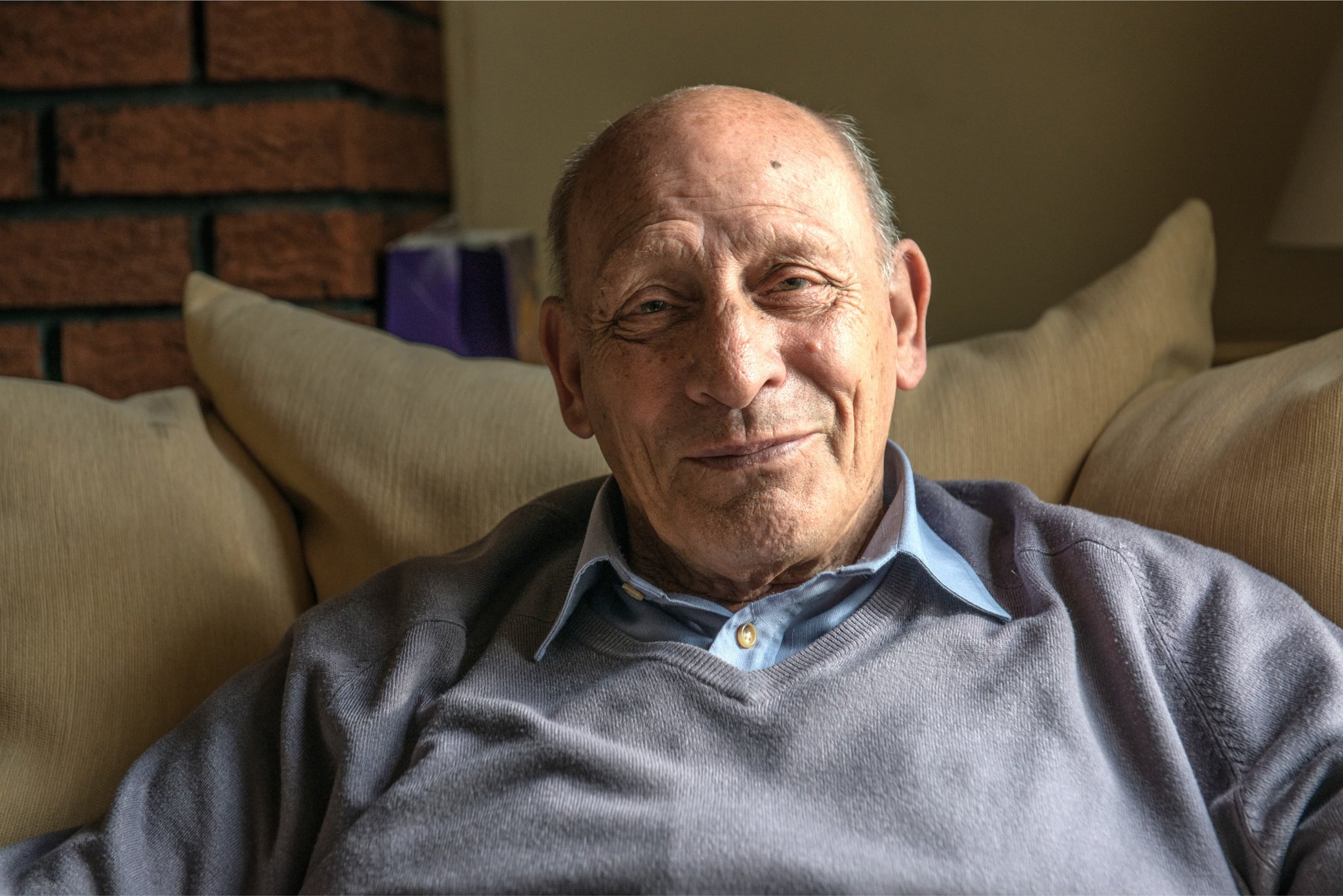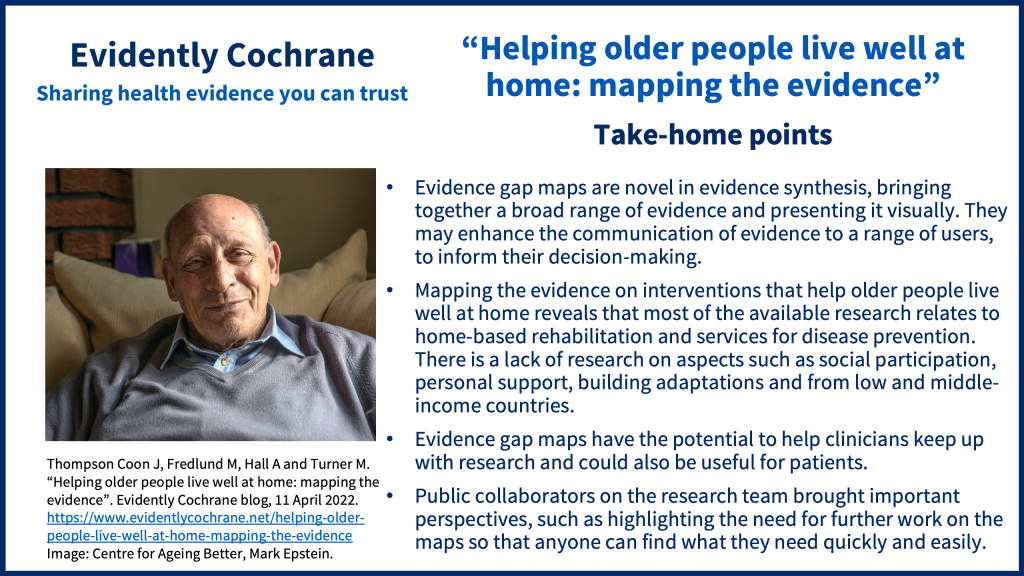In this blog, a team from the University of Exeter write about evidence gap maps, a way of visually presenting an overview of the available evidence on health topics and showing where the gaps are. Researchers Jo Thompson Coon and Mary Fredlund summarise the key messages from a map on home-based health and social care and mobility interventions to improve the functional ability of older adults living at home, relevant to researchers, health care professionals and patients. Physiotherapist and researcher Abi Hall explores how she has used the evidence and gap map in her clinical practice, and public collaborator Malcolm Turner reflects on how the map could be used by patients and the public.
Featured image: Centre for Ageing Better, Mark Epstein.
Take-home points
Why is this important?
In a society where more people are living longer, there is an increasing need to develop and share evidence of effective ways to ensure people continue to live well in their later years. For many, this means maintaining the ability to live in their own homes. As people age, deteriorating sight or hearing, declining strength or neurological function and reduced mobility or social networks can compromise them living at home in safe and healthy ways. One way to respond to this is to make adaptations. For example, adapting the home so that daily tasks are still achievable or changing how people interact with family and friends.
Health and social care professionals have a central role in informing decisions regarding which interventions are needed, for whom, as well as when – and how – to employ them to maximum effect. To do this, they need to be able to understand and present evidence about which strategies or adaptations are likely to be reliable and effective in achieving the desired outcome of living at home to individuals and their families. More fundamentally, they need to have access to – and digest – the evidence base.
What is an evidence gap map?
Evidence gap maps offer an immediate visual overview of the evidence on a topic and enable a vast amount of information to be presented together in a curated, organised manner. They are a novel innovation in evidence synthesis; importantly they increase the breadth of evidence that can be synthesised together. They are also intended to enable the effective communication of evidence to a range of users in order to empower their subsequent decision-making.
Typically, evidence gap maps display what evidence there is, where it is, and where there are gaps in the evidence base. They can also indicate some of the details about the type and nature of that evidence.
How did we make the evidence gap map?
The map was produced by the Cochrane Campbell Global Ageing Partnership and published in the Campbell Library. To ensure a diverse range of insights, the team included members of the public, clinical practitioners, and policy makers from around the world. Our aim was to identify studies and systematic reviewsIn systematic reviews we search for and summarize studies that answer a specific research question (e.g. is paracetamol effective and safe for treating back pain?). The studies are identified, assessed, and summarized by using a systematic and predefined approach. They inform recommendations for healthcare and research. of health and social support services, as well as assistive devices designed to support functional ability, of older adults living at home or in other places of residence.
How do you use the map?
The evidence is shown as bubbles within the matrix. The bigger the bubble the more studies there are reporting that outcome for that interventionA treatment, procedure or programme of health care that has the potential to change the course of events of a healthcare condition. Examples include a drug, surgery, exercise or counselling. . The colour of the bubbles indicates the type of evidence; low and critically low-quality systematic reviews (red), moderate-quality systematic reviews (green), high-quality systematic reviews (blue) and randomisedRandomization is the process of randomly dividing into groups the people taking part in a trial. One group (the intervention group) will be given the intervention being tested (for example a drug, surgery, or exercise) and compared with a group which does not receive the intervention (the control group). controlled trialsClinical trials are research studies involving people who use healthcare services. They often compare a new or different treatment with the best treatment currently available. This is to test whether the new or different treatment is safe, effective and any better than what is currently used. No matter how promising a new treatment may appear during tests in a laboratory, it must go through clinical trials before its benefits and risks can really be known. (purple). Clicking on a cell within the matrix gives a list of studies which report on evidence with the corresponding intervention and outcomesOutcomes are measures of health (for example quality of life, pain, blood sugar levels) that can be used to assess the effectiveness and safety of a treatment or other intervention (for example a drug, surgery, or exercise). In research, the outcomes considered most important are ‘primary outcomes’ and those considered less important are ‘secondary outcomes’..
Information in the map can be filtered according to publication status, age group, health condition, WHO region, World Bank Classification (whether the evidence is from a low, lower-middle, upper-middle-, or high-income country) and proportion of women included in the studyAn investigation of a healthcare problem. There are different types of studies used to answer research questions, for example randomised controlled trials or observational studies..
What does the map show?
There are 120 systematic reviews and 428 randomised controlled studiesA trial in which a group (the ‘intervention group’) is given a intervention being tested (for example a drug, surgery, or exercise) is compared with a group which does not receive the intervention (the ‘control group’). in the map, although it is important to note that many of the studies report multiple outcomes and a single study or review may appear in multiple cells. There is also overlap between systematic reviews and randomised controlled trials, with the trials appearing in the map whether or not they are also included in a review.
Which areas have been most researched?
A quick look at the map reveals that most of the evidence relates to home-based rehabilitation and home-based services for disease prevention, mostly delivered by healthcare professionals.
The most frequently reported outcomes were:
- mental and neuromuscular function
- basic needs
- mobility
What are the evidence gaps?
We identified far fewer studies on:
- personal mobility
- building adaptations
- family support
- personal support and befriending or friendly visits
Given that these elements are valued by people and considered important to having a good quality of life then the gap in the evidence map provides an important steer for the direction of future research. It highlights the need for evidence on which interventions effectively sustain, and where needed re-gain, these aspects to ensure that living at home equates to living well.
The map highlights some other important gaps in the evidence base. For example, there were few studies which examined the impact of interventions on:
- social participation
- financial security
- communication
These elements have a bearing on a person’s wellbeing; therefore undertaking studies on which interventions are effective in contributing to wellbeing is needed. There is also a lack of studies conducted in low- and middle-income countries and few studies which considered health inequity.
How could the map be used in clinical practice? Reflections from Abi Hall
This visual representation of evidence, and where the gaps are, has huge potential to help clinicians like me to keep up with the state of research.
Clinical life is busy – COVID-19 has only exacerbated that. Being a manager is fraught with challenges and pressures. However, the one thing that is always central to my thinking – whether acting as a manager or as a clinician – is wanting to do the best for the patients I am responsible for, and ensuring the clinicians I work with do the same. Taking time to seek out research papers and look for the new evidence, unfortunately is not always top of the list of priorities. So the opportunity to be able to have a visual representation of what evidence there is – and possibly more importantly there isn’t – for certain outcomes has massive potential benefits to me and other clinicians, particularly those interested in carrying out research.
A visual representation demonstrating what interventions have evidence may also be of value and interest to patients. I’ve always felt very privileged that patients trust what I’m saying to them – they trust that I am informed, they trust that I am helping them to make the right decisions. Over the years, patients have – in my opinion – become much more engaged with asking questions about their treatmentSomething done with the aim of improving health or relieving suffering. For example, medicines, surgery, psychological and physical therapies, diet and exercise changes. and wanting to be educated about their condition. However, it’s very rare that I meet a patient who actively asks to read a research paper. While not being designed specifically for patients, I would be interested to see how evidence gap maps might be adapted to make it more “user-friendly” for patients. The ability to use the tool to guide shared decision-making during discussions with patients could be of particular value.
How could the map be used by patients and members of the public? Reflections from Malcolm Turner
As a public collaborator, I am looking at the value of evidence gap maps as a source of reliable information to help with decision-making for family, friends and anyone wanting to make a more informed healthcare decision. Exploring evidence gap maps was new to me. However, I found that being able to discover specific topics and areas of research in a visual manner – and then to be able to drill down to more detailed information on particular topics more relevant to my interests – was very exciting.
Was it easy to use? Maybe not. With my IT limitations, both in practical terms and when only using a laptop computer with a small screen, navigating the dataData is the information collected through research. did present some problems. Whilst I have many skills and a lot of lived experience, I still find IT challenging. Indeed some family members have neither access to, nor interest in, new technologies!
For me, the excitement of thinking that there might be a proven answer to my interest or query was tempered with a frustration that the purpose of evidence gap maps is to show what evidence there is and doesn’t immediately answer my purpose to find out what the evidence says.
Yes, I know that I can dive down into more detail, but this can be both time consuming and challenging. For example, for the outcome of falls, there were 70 records. That is a mind-blowing amount of information. How would I find what I want quickly and easily? Faced with this volume of evidence, I would probably not continue to use the map as an approach to access evidence but would resort to a medical practitioner or maybe Google my topic. I also find the inclusion of low-quality evidence in the map confusing – as a patient I’m only interested in reading the best available evidence.
What next?
The map was used to inform the baseline report for the United Nations Decade of Healthy Ageing and will continue to serve as a resource to highlight priorities for research activity. As Abi reflects, there are also exciting opportunities for clinicians to use the map in their clinical practice. Although finding new ways to introduce the map to clinical audiences and to demonstrate its potential may be necessary.
At a methodological level, it is clear that further innovation is needed before evidence and gap maps can fully realise their potential. Whilst there is huge value in being able to represent a large volume of evidence in a visual, interactive format, evidence gap maps are not currently accessible to all. In particular, there is work needed to make them user-friendly for patients.
- View the evidence gap map
- Find out more: Health, social care and technological interventions to improve functional ability of older adults living at home: An evidence and gap map
Join in the conversation on Twitter with @CochraneUK or leave a comment on the blog.
Please note, we cannot give specific medical advice and do not publish comments that link to individual pages requesting donations or to commercial sites, or appear to endorse commercial products. We welcome diverse views and encourage discussion but we ask that comments are respectful and reserve the right to not publish any we consider offensive. Cochrane UK does not fact check – or endorse – readers’ comments, including any treatments mentioned.
Jo is a co-author of the evidence and gap map which is the subject of this blog post. The other authors have nothing to declare.
Jo’s biography appears below. Read Mary’s biography; Abi’s biography and Malcom’s biography.
Reference:
Welch V, Mathew CM, Babelmorad P, Li Y, Ghogomu ET, Borg J,…Howe TE, et al. Health, social care and technological interventions to improve functional ability of older adults living at home: An evidence and gap map. Campbell Systematic Reviews, Volume 17, Issue 3, September 2021, e117. https://doi.org/10.1002/cl2.1175



